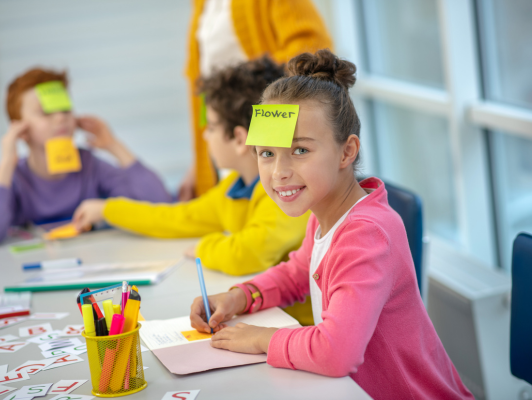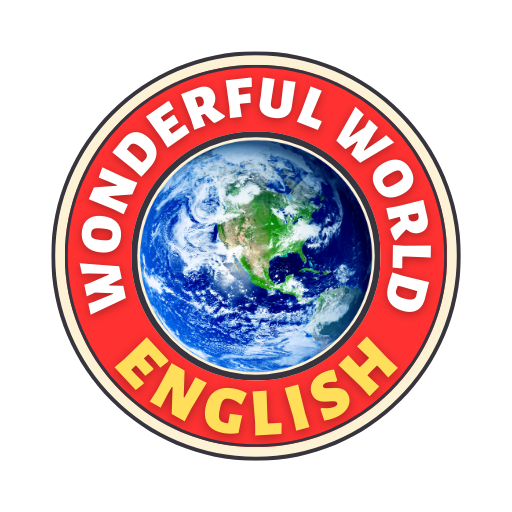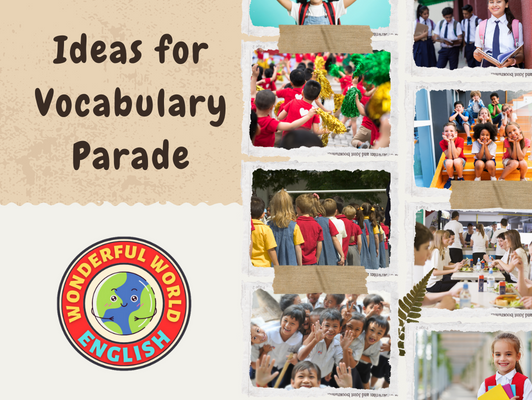Contents
Toggle
Meet David De’ Ath, founder, editor, and writer at Wonderful World English. With his extensive background as an English teacher, David provides valuable insights and practical tips on ESL for students and teachers alike.
A vocabulary parade is a creative educational event where students have the opportunity to express their understanding of different words through costumes and displays.
This concept, inspired by Debra Frasier’s book “Miss Alaineus, A Vocabulary Disaster,” has become a fun and interactive way to enhance vocabulary learning.
During the parade, students design and wear costumes that illustrate the meaning of a specific vocabulary word assigned or chosen by them.
This kinesthetic approach to learning fosters creativity and reinforces the understanding of word meanings in a memorable fashion.
Teachers see the vocabulary parade as a tool for engagement, allowing students to immerse themselves in words beyond the confines of paper and classroom discussions.
It encourages collaboration as students often help each other with costume ideas and construction, building a community of learners who benefit from each other’s insights.
The vocabulary parade serves as a culminating celebration of words, bringing energy and enjoyment to the learning process.
As students parade around the school or a designated area, they showcase their costumes to peers and educators, making the vocabulary more tangible and accessible.
For students, this method transforms learning vocabulary from a singular, often solitary activity to a communal celebration of language.
The parade caters to different learning styles as students think critically about visually representing their chosen words.
Moreover, the social component adds a layer of communication skills as students explain their costumes and the meanings behind them.
As a result, a vocabulary parade can significantly contribute to a student’s language development and confidence in using new words.
Planning Your Vocabulary Parade
Organizing a Vocabulary Parade is an excellent way for students to engage with new words and their meanings through a creative and fun event.
It involves selecting a word, defining it, and designing a costume representing the word. Here is how to plan your Vocabulary Parade effectively.
Setting a Theme
Determining an overall theme can give coherence to your Vocabulary Parade and spur creativity.
Themes could be based on subjects like Science, Literature, or a mix where students can pick any word from a certain Lexical Category, like adjectives or verbs.
This theme will guide the students in their choice of words and ensure a diverse yet organized display of vocabulary.
Choosing Words and Definitions
It is crucial for teachers to provide a guide with clear rules on how students should select their vocabulary words and their definitions. This could involve:
- Providing a list of words to choose from, ensuring they are appropriate for the students’ grade level.
- Allowing individual word selection with teacher approval to encourage discovery of new words.
- Encouraging creativity and fun in how the words and definitions are represented in students’ attire.
Creating Invitations and Guidelines
Invitations to the event should be sent to parents and other classes to come and watch the parade, enhancing community involvement.
The invitations should include:
- Date and time of the event.
- A clear set of guidelines and rules for participation.
- A suggestion to bring supplies to support their child’s costume creation.
A well-planned Vocabulary Parade not only aids in vocabulary building but also promotes creativity and community engagement among students, teachers, and parents.

Designing Costumes
Designing costumes for a vocabulary parade combines creativity with education, encouraging students to express their chosen words through flamboyant and fun attire.
This process allows for a dynamic way to engage with language and exhibit understanding.
Costume Guidelines and Inspiration
When selecting a costume idea, students should aim for a clear representation of their chosen vocabulary word.
Teachers can provide a kit or list of recommended vocabulary words to spark costume ideas.
For example, the word “jailed” might inspire the image of a student with bars across a black and white striped shirt, creatively indicating the word’s meaning.
- Creative: Encourage the use of puns or playful interpretations that respect the school’s dress code.
- Fun: The goal is to enjoy the process as much as the parade itself, so choosing a word that excites the student will yield the best results.
Gathering Materials and Supplies
To bring a vocabulary parade costume to life, a variety of materials and supplies are required.
Begin by listing what items are needed for the costume’s basic structure and any decorative elements to convey the word visually.
- Art Supplies: These can include fabric, paint, cardboard, or recycled materials.
- Resources: Utilize everyday items in inventive ways—a sponge secured to a hat to represent “soak,” for example.
Students and teachers can gather supplies from classroom resources or by involving parents and the community to donate items.
Crafting and Construction
The actual assembly of the costume allows for the students’ creativity to shine.
Depending on the design’s complexity, this may occur across several days or as part of a dedicated class project.
- Simple Constructions: Attach paper water drops around a hat to symbolize ‘soak.’
- Detailed Creations: Design a costume with an ambiguous book cover to represent ‘anonymous.’
Always prioritize safety when crafting, especially when using scissors, glue, and other art tools.
With these elements in mind, students are able to delve into their creative capabilities and produce costumes that are both educational and enjoyable.

Educational Activities
In a vocabulary parade, educators have the opportunity to reinforce language knowledge through dynamic lessons and integrate learning across various subjects.
This section details specific activities that can both challenge and entertain participants.
Vocabulary Lessons and Games
Teachers can kickstart the vocabulary parade by assigning each student a vocabulary word.
They can make the selection process a game in itself, encouraging students to draw words from a hat to ensure variety.
Once every student has a word, the class can engage in a series of activities to deepen their understanding of the words:
- Word Definitions: Students research and present their word’s definition, usage, and an interesting fact about its origin.
- Create a Sentence: Challenge students to craft a sentence using their word correctly, promoting the practical application of their new vocabulary.
- Vocabulary Stories: They can write short stories that incorporate all of their vocabulary words, thus reinforcing their understanding through creative writing.
Incorporating Other Subjects
The act of organizing a vocabulary parade provides a unique opportunity to blend subjects and learning outcomes:
- Math Integration: Incorporate math by having students keep track of the number of syllables, letters, or even the frequency of their word’s usage in texts as a statistical challenge.
- Nouns and Science: If a student’s word is a noun, particularly one related to science, it could be accompanied by a visual representation or a practical demonstration during the parade.
Ultimately, these educational activities aim to expand vocabulary knowledge through engaging, interdisciplinary lessons and games, making the parade an event that goes beyond just a display of costumes and becomes a comprehensively enriching academic experience.
For a complete guide on vocabulary games and activities that you can include in a parade, check out the link below!
Related: Fun Vocabulary Activities: 10 Ways to Boost Word Skills

Day of the Parade
The vocabulary parade is a day filled with excitement as students showcase their creativity and love for words.
Parents and teachers witness the hallways come alive with music and laughter, making it an enriching experience for all.
Organization and Logistics
On the day of the parade, clear rules and guidelines are essential to ensure a smooth flow of events.
Students should gather in a designated area for pre-parade preparations.
It’s advisable to have volunteers or staff available to assist students with their costumes and to organize them sequentially.
Here’s a brief checklist:
- Assembly Area: Confirm the space is large enough for all participants.
- Student Line-Up: Arrange students alphabetically or by grade level.
- Route: Plan a parade route through the school hallways, avoiding congestion points.
- Timing: Schedule start and end times, including any breaks needed for younger students.
- Safety: Have a safety plan for the students and spectators.
Judging and Awards
To add a competitive element and recognize the hard work of the participants, a judging panel can evaluate the costumes based on creativity, complexity, and accuracy of the word depiction.
Awards can be given for various categories, such as:
- Most Creative Use of Materials: Rewarding students who have used unique materials to bring their word to life.
- Best Representation of a Word: Recognizing the student whose costume represents their chosen word with exceptional detail and clarity.
- Most Enthusiastic Participant: Honor a student who exudes joy and embraces the spirit of the vocabulary parade.
Organizers can announce winners at the end of the parade or during a closing ceremony, ensuring compliance with all school rules and maintaining a positive atmosphere.

Wrapping Up the Event
After celebrating the joy of learning new vocabulary, the close of a Vocabulary Parade offers a perfect opportunity to commemorate the day and show appreciation to those who contributed to its success.
Photo Sessions and Sharing
At the end of a Vocabulary Parade, participants gather for photo sessions, providing a chance to showcase their creative costumes and the words they represent.
Organizers can set up themed photo booths where students, teachers, and parents capture these moments.
These photos can then be compiled in an album or shared on the school’s website or social media pages, creating lasting memories and a resource for other schools and communities to draw inspiration from for their own events.
Thank You Notes and Acknowledgments
Concluding the parade, it’s important to acknowledge the efforts of everyone involved.
Handwritten thank-you notes can be a personal and meaningful gesture.
These notes should be sent to:
- Teachers who integrated the Vocabulary Parade into their curriculum, assisting students in word selection and costume creation.
- Parents who supported their children in the construction of outfits and joined in the festivities.
- Volunteers who handled the logistics of the parade, ensuring a smooth and enjoyable event.
Acknowledgments may also take the form of public recognition during a school assembly, highlighting the commitment and creativity that made the Vocabulary Parade a success.

Resource Guide
In planning a vocabulary parade, educators can greatly benefit from a variety of resources that provide guidance and inspiration.
Books and online materials offer a wealth of ideas to help teachers and students come up with creative costumes that celebrate the joys of learning new words.
Books and Literature
- Miss Alaineus, A Vocabulary Disaster: This book serves as a cornerstone for the vocabulary parade concept. It tells the story of a girl who participates in a school vocabulary parade, providing both narrative inspiration and clear examples of how a word and its definition can be visually represented.
- Resource Books: Various educational publishers offer books with ready-made lists of vocabulary words, along with their definitions. These can be used to help students choose words that are both challenging and can be translated into an interesting costume.
Online Resources and Printables
- Printable Word Lists: Websites such as Scholastic offer downloadable PDFs that include a vast array of vocabulary words suitable for a parade, helping to spark costume ideas.
- Educational Videos: Teachers can access videos that read aloud stories like “Miss Alaineus,” giving students a more interactive way to engage with the vocabulary parade idea.
- Costume Examples: Online galleries and tutorials can show pictures and step-by-step instructions for creating inventive costumes that correspond to specific vocabulary words.
- Poster Signs: Templates for signs and posters can be obtained online, which students can use to accompany their costumes, displaying the selected word and its definition prominently.
Related: How to Teach Vocabulary to ESL Students: Teacher’s Guide

Case Study: Miss Alaineus, A Vocabulary Disaster
This section examines Debra Frasier’s “Miss Alaineus, A Vocabulary Disaster” and extracts educational lesson ideas from the text to inspire vocabulary parades.
Overview of the Book
“Miss Alaineus, A Vocabulary Disaster” is a children’s book written by Debra Frasier that revolves around a third grader named Sage.
She misunderstands a vocabulary word, which results in a comical and educational story.
The word in question, “miscellaneous,” is mistaken for the name “Miss Alaineus,” leading to an embarrassing but insightful situation that motivates a school-wide vocabulary parade.
The narrative emphasizes the importance of understanding words and definitions while injecting a sense of creativity and fun into the learning process.
Lesson Ideas from the Book
In the spirit of the book, teachers can create vocabulary parade activities that encourage students to engage with their vocabulary words in imaginative ways.
Here are some concrete ideas drawn from Frasier’s book:
- Brainstorming Session: Students list vocabulary terms from a recent unit and think of inventive ways to represent these words visually.
- Costume Design: Each student selects or is assigned a vocabulary word to embody, crafting a costume that captures the essence of their chosen term.
By enacting these lesson ideas, educators can make vocabulary studies an interactive and memorable experience, much like Sage’s journey in “Miss Alaineus, A Vocabulary Disaster.”
The goal is for students to deepen their understanding of new words while enjoying the creativity that a vocabulary parade can inspire.

Conclusion
A vocabulary parade serves as an engaging and interactive strategy to enrich students’ lexicon, fostering a solid grasp of new and relevant terms.
The active participation of teachers in guiding and inspiring students proves fundamental in this endeavor.
Students thrive when they correlate words with creative representations, thereby solidifying their knowledge.
Parents can offer instrumental support by assisting their children with costume preparation, instilling a collaborative spirit that extends the learning environment beyond the classroom.
Such activities encourage a comprehensive community approach to education, wherein each stakeholder contributes to the students’ learning journey.
Ultimately, a vocabulary parade transcends mere academic exercise; it is a reflection of collective effort, creativity, and the joy of learning.
The experience leaves a lasting impression on young minds, emphasizing the power and fun inherent in language mastery.
| Stakeholder | Role in Vocabulary Parade |
|---|---|
| Students | Select and personify words, engage in learning |
| Teachers | Provide guidance, structure the event |
| Parents | Support with resources, bolster motivation |
By holding a parade, schools effectively create a memorable and educational experience that champions the value of vocabulary in communication and comprehension.
We hope you found value in this guide; feel free to reach out if you require any support.
Have a wonderful day!
Image Attribution: All images licensed via canva.com





